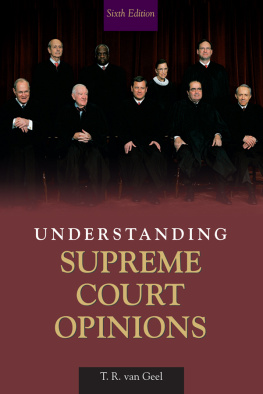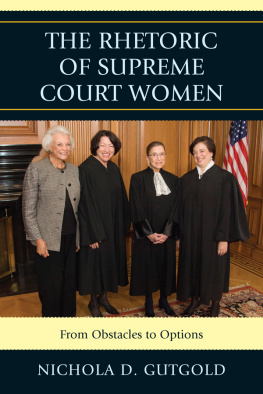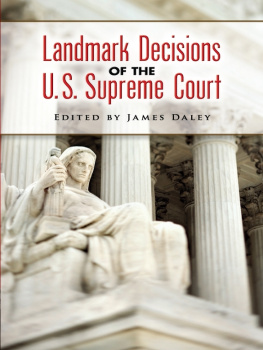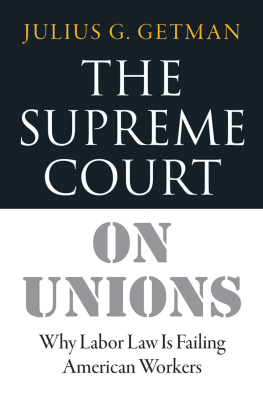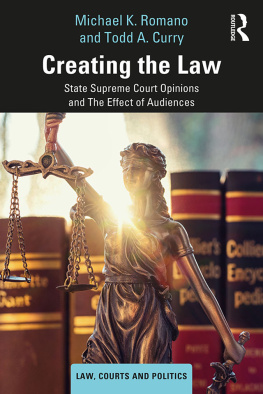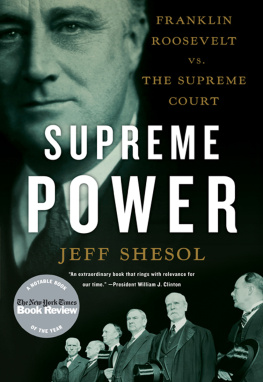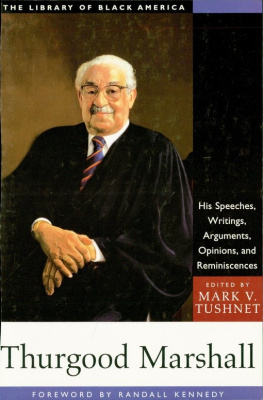Understanding
Supreme Court
Opinions
Understanding
Supreme Court
Opinions
_____________________
SIXTH EDITION
T. R. van Geel
Professor Emeritus, University of Rochester
For my colleagues and friends at the
University of Rochester
First published 2009 by Pearson Education, Inc.
Published 2016 by Routledge
2 Park Square, Milton Park, Abingdon, Oxon OX14 4RN
711 Third Avenue, New York, NY 10017, USA
Routledge is an imprint of the Taylor & Francis Group, an informa business
Copyright 2009 Taylor & Francis. All rights reserved.
All rights reserved. No part of this book may be reprinted or reproduced or utilised in any form or by any electronic, mechanical, or other means, now known or hereafter invented, including photocopying and recording, or in any information storage or retrieval system, without permission in writing from the publishers.
Notice:
Product or corporate names may be trademarks or registered trademarks, and are used only for identification and explanation without intent to infringe.
Credits and acknowledgments borrowed from other sources and reproduced, with permission, in this textbook appear on appropriate page within text.
ISBN: 9780205621613 (pbk)
Cover Designer: Bernadette Skok
Library of Congress Cataloging-in-Publication Data
Van Geel, Tyll.
Understanding Supreme Court opinions / T. R. van Geel.6th ed.
p. cm.
Includes index.
ISBN-13: 978-0-205-62161-3
ISBN-10: 0-205-62161-9
1. United States. Supreme Court. 2. Judicial processUnited States. 3. Judicial
opinionsUnited States. 4. Constitutional lawUnited States. I. Title.
KF8742.V36 2009
Contents
T his book provides an introduction to the legal reasoning and the modes of persuasion and justification used by Supreme Court justices, as well as others engaged in constitutional adjudication. It attempts to provide a new perspective on the workings of the Supreme Court, and also seeks to shed new light on the workings of our constitutional system and to enrich our understanding of the notion of the rule of law.
The book is intended to be used in several ways. It is designed to be used as a supplement to a constitutional law casebook, as well as in combination with materials written from the perspective of the political scientist.
Understanding Supreme Court Opinions, Sixth Edition, incorporates materials on opinions issued by the Supreme Court since the Fifth Edition was published. These recent opinions address such issues as the authority of the police to engage in searches of ones home, the authority of school districts to regulate student speech, the presidents power as it relates to the war on terror, the constitutionality of executing a delusionary felon, and the constitutionality of school district efforts to correct racial imbalance in their schools by integration plans that rely on a racial criterion.
In addition, important changes have been made in central chapters of the book to clarify the material and to assist students. help to communicate more clearly the key points of the chapters and help to preserve the original length of the volume.
Finally, a new illustrates and discusses in great depth the briefing and analysis of a recent Supreme Court case, Parents Involved in Community Schools v. Seattle School District No. 1. In this case, the Supreme Court barred two school districts from using race as a criterion in admitting students to schools the students had selected under a freedom of choice plan. The detailed commentary is included to help students understand the process of briefing a case, and the accompanying follow-up analysis provides them with an illustrative example of how to undertake an in-depth constitutional analysis of a opinion.
The development of this Sixth Edition was enhanced by the insightful comments by several reviewers:
Philip Dynia, Loyola University
Ray Kessler, Sul Ross State University
Chris Bonneau, University of Pittsburgh
I also want to thank Jason Blokhuis for his able assistance in reviewing and editing.
T R. van Geel
S ome years ago, when I was in college and about to go on to law school, I had a conversation with a lawyer in my hometown. He told me that I would enjoy law school if I enjoyed reading lots of little stories. Well, in law school I did read lots of little stories, but it was also clear that what that lawyer had told me was misleading. It was true that the judicial opinions I read were stories with considerable human conflict, drama, and passion. But by calling these accounts little stories he had intimated that these stories were not complex and intricate. He seemed to suggest that they were no more than a series of interesting anecdotes. In reality, each was more like a Shakespearian play with multiple characters, a complex structure, densely packed language, and several layers of meaning. These were not mere tabloid accounts of human conflict, but rich pieces of writing that even with multiple readings yielded new insights.
The reading and understanding of law is often compared to the reading and understanding of literature, but let me suggest a different comparison. You are a historian of ancient Rome, and you are working with the speeches of a famous Roman senator delivered in the Roman senate. In trying to understand the meaning and significance of these speeches you will be asking yourself these and other questions:
What social function did the giving of speeches serve? Why did this senator and other senators give speeches? What role did the Roman senate have in the system of government?
On what occasion was this speech given? Who was the audience?
Under what constraints did a senator operate when delivering a speech?
Were there things that Roman senators could not say or were expected to say?
What was the logical argument of the speech? What point was it making and how did it justify that point?
What materials did the speech rely on to make its point?
Were the assumptions and premises of the speech plausible at that historical moment in time? Are they still plausible today?
How does this speech compare with previous speeches given by the same senator? other senators? Are there different styles of speeches?
What underlying values and beliefs were embodied in the speech?
What were the political, economic, and social effects of this speech?
The questions you may wish to ask about the speeches of the Roman senate are in many respects the same questions you should be asking about the opinions of the U.S. Supreme Court. As was true of the speeches of the Roman senators, the opinions of Supreme Court justices are written within a particular institutional setting and are designed to serve certain social, political, and, of course, legal functions. A judicial opinion must be understood in light of the institutional setting in which it was written. Not the least of these functions is that these opinions are intended to be persuasive arguments. The opinion is designed to convince the reader that the judgment reached in the casethe bottom linewas correct.
You need to understand all this as well as why this particular opinion was being delivered at this time. How did it come to be that the Supreme Court rendered this opinion at this point?


